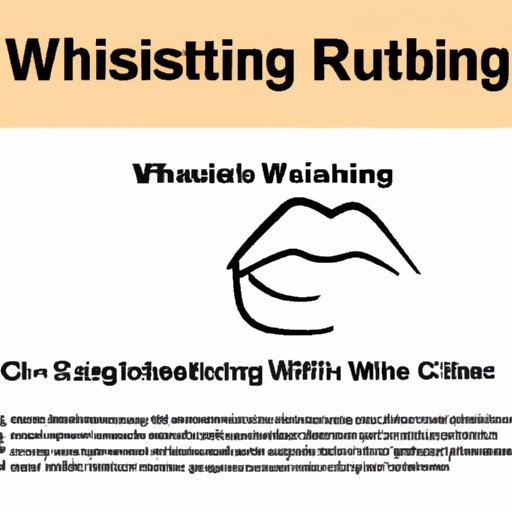
Introduction
Whistling has been an important part of human history and can be found in cultures all around the world. From signaling to birdsong, it has served a variety of purposes throughout the ages. In this article, we will explore the basics of whistling, different techniques and styles, its therapeutic benefits, how to incorporate it into your daily routine, and its cultural significance. Whether you are a beginner or someone looking to impress an audience, this guide will help you master the art of whistling.
Whistling 101: A Beginner’s Guide to Mastering the Art of Whistling
Whistling is considered a natural ability that anyone can learn with practice. To begin, position your lips into a small circle, tucking the corners into your mouth and resting the tip of your tongue towards the back of your teeth. The position of your tongue can help you control the pitch and volume of your whistle.
Experiment with your breath control and lip tension to find the pitch and volume that works best for you. With time and practice, you can adjust your technique to produce different sounds.
Get started with some simple melodies like “Mary Had a Little Lamb” or “Twinkle, Twinkle, Little Star.” Start with a short melody and repeat it often, slowly increasing the speed as you get more comfortable.
Different Types of Whistling Sounds and How to Make Them
After mastering the basic whistle, the next step is to experiment with different types of whistling sounds like trills, vibrato, and glissando.
The trill is made by rapidly alternating between two pitches. To create a trill, start by making a simple whistle and then move your tongue quickly up and down.
Vibrato is a slight variation in pitch as the whistle is sustained. To create vibrato, gently vary your breath pressure to create a fluctuation in pitch as you whistle.
Glissando is a variation of pitch that moves up or down the scale in a smooth, flowing motion. To create glissando, start by whistling a note, then gradually increase or decrease the pitch by moving your tongue up or down.
Each of these techniques takes practice to master, so experiment with each one and see what works for you. Start slow and gradually increase speed and complexity.
Whistling for Relaxation: The Benefits of Whistling and How to Incorporate it into Your Daily Routine
Whistling has been found to have therapeutic benefits, including reducing stress and anxiety. It can also help improve your breathing and overall respiratory health.
Consider incorporating whistling into your daily routine. Take short breaks throughout your day to whistle a simple tune or meditate using sustained whistling. Or try whistling along to music when exercising or doing chores.
Experiment with different styles and techniques and see what helps you feel the most relaxed and centered.
The Art of Whistling for Performance: Tips and Tricks for Impressing Your Audience
If you’re interested in incorporating whistling into a performance, there are a few tips and tricks to keep in mind.
Choose the right song that showcases your abilities and use a microphone to amplify your whistle. Experiment with different techniques, like incorporating trills or vibrato into your melodies, to create a more complex sound.
Practice is key. Record yourself and analyze your performance to identify areas for improvement. Keep practicing and experimenting until you find the perfect sound.
Whistling Around the World: Exploring the Cultural Significance of Whistling in Different Countries
Whistling has cultural significance in many different countries, playing a role in language, music, and everyday life.
In Mexico, whistling is used to call people from a distance or signal for help. In the Canary Islands, it is incorporated into traditional music. In Turkey, it is used to convey detailed musical phrases and forms a part of their classical music culture.
Take a look at famous whistling tunes from different countries, like “The Colonel Bogey March” from Great Britain, “El Silbo” from La Gomera, Spain, or “Uzun İnce Bir Yoldayım” from Turkey.
Conclusion
Whistling is an art form that has been around for centuries and can be found in cultures all around the world. Whether you are a beginner or someone looking to enhance your skills, mastering the art of whistling takes patience, practice, and experimentation.
By exploring different techniques and styles and incorporating whistling into your daily routine, you can reap the therapeutic benefits and gain a greater appreciation for this unique and versatile art form.





